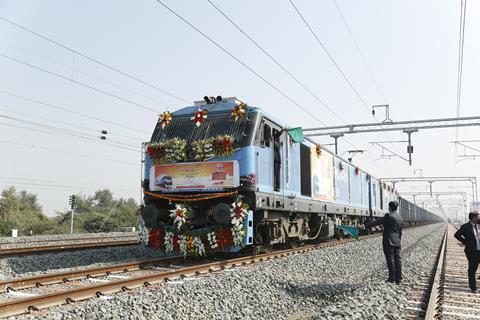
INDIA: Despite the ongoing challenges of the Covid-19 pandemic, Indian Railways has reported record-breaking freight loadings for the second year in succession.
Announcing its provisional results for the 2021-22 financial year to March 31, IR reported that it had broken the 1 400 million tonne level for originating freight, achieving a total of 1 418·1 million tonnes. This is 185 million tonnes up on the 1 233·3 million tonnes carried in 2020-21, which was itself a record (Table I).
The 15% growth in volume was IR’s best ever year-on-year increase; the previous best was 10·7% achieved in 2005-06. The increased traffic brought a similar record in freight revenues at Rs1 437·3bn, well ahead of the previous best of Rs1 253·4bn earned in 2018-19.
The year-on-year increase of 185 million tonnes has primarily been led by coal, which remains IR largest single commodity, followed by cement and, significantly, the much sought-after break-bulk miscellaneous freight designated as ‘Balance Other Goods’. All commodities contributed to the increase except fertilisers, where demand was subdued by volatile prices on the international market (Table II).
| Table I. IR freight traffic records | ||||
|---|---|---|---|---|
| * Provisional results | ||||
|
|
Current record |
Period |
Previous best |
Period |
|
Freight loading million tonnes |
1 418·1 |
FY-21-22* |
1 233·3 |
FY 20-21 |
|
Gross freight revenue Rs bn |
1 437·3 |
FY-21-22* |
1 253·4 |
FY 18-19 |
|
Incremental increase million tonnes |
185 |
FY 21-22* |
66·1 |
FY 07-08 |
|
Average wagons per day |
62 885 |
FY -21-22* |
54 469 |
FY 20-21 |
|
Highest loading in a single day |
106 227 wagons |
March 31 2022 |
103 737 wagons |
March 31 2021 |
|
Highest loading in a month million tonnes |
139·3 |
March 2022 |
130·5 |
March 2021 |
|
Net tonne-km billion |
820 |
2021-22 |
702 |
2018-19 |

Customer-first strategy
Over the past two years, IR has been working to attract additional business under a campaign entitled ‘Hungry for Cargo’. Negotiations with major industries and shippers focused on both increasing the volumes of conventional bulk goods as well as break-bulk commodity streams to expand the reach of its freight operations.
Steps taken by IR’s business development managers at both policymaking and operational levels seem to have instilled a new ethos of customer-centric service orientation and improved performance. Recognising the need for agility and resilience, as well as reliability and value for money, IR has been working to rationalise its tariff structures and simplify its procedures, embracing technology and improving transit times, with the introduction of guaranteed schedules. This has yielded dividends, attracting new traffic to rail and boosting IR’s revenue stream.
| Table II. IR traffic increase by commodity | ||||
|---|---|---|---|---|
| * Provisional results | ||||
|
million tonnes |
2020-21 |
2021-22* |
Increase |
Growth % |
|
Coal |
542·2 |
653·3 |
111 |
20·5 |
|
Raw materials for steel plants (including iron ore ) |
183·7 |
197·2 |
13·5 |
7·3 |
|
Finished steel and pig iron |
59·3 |
68·3 |
8·9 |
15·1 |
|
Cement and clinker |
121·2 |
138·5 |
17·2 |
14·2 |
|
Food grains |
62·8 |
73·4 |
10·5 |
16·7 |
|
Fertilisers |
54·1 |
49·5 |
-4·6 |
-8·5 |
|
Petrol, oil and liquids |
43·0 |
45·0 |
2·0 |
4·7 |
|
Containers |
63·2 |
74·3 |
11·1 |
16·9 |
|
Balance Other Goods |
103·3 |
118·4 |
15·0 |
14·5 |
|
Total |
1 233·1 |
1 418·1 |
185·0 |
15·0 |

















